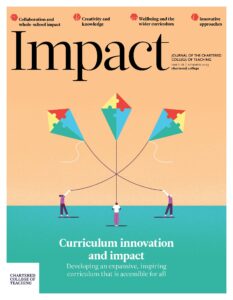Designing a Key Stage 3 drama curriculum that is ambitious for all
Written by: Holly Sullivan

7 min read
HOLLY SULLIVAN, HEAD OF CREATIVE AND EXPRESSIVE ARTS, ALICE SMITH SCHOOL, KUALA LUMPUR, MALAYSIA
Mary Myatt encourages teachers to think of Key Stage 3 as the ‘intellectual powerhouse of the secondary school’, in which ‘students are entitled to a broad and diverse curriculum until the end of it’ (quoted in Amass, 2022). Designing a creative programme of study that engages and challenges all its students can be both liberating and overwhelming for drama subject leads. As Sir Ken Robinson extolled in his report All our futures (1999, p. 6), ‘Creativity is not simply a matter of letting go. Serious creative achievement relies on knowledge, control of materials and command of ideas.’ How might a drama team design an ambitious intellectual curriculum, rooted in knowledge, control and command of ideas, that does not narrowly teach to the test of GCSE and A-level? This case study explores the rationale for one drama department’s Key Stage 3 curriculum design.
At the Alice Sm
Join us or sign in now to view the rest of this page
You're viewing this site as a guest, which only allows you to view a limited amount of content.
To view this page and get access to all our resources, join the Chartered College of Teaching (it's free for trainee teachers and half price for NQTs) or log in if you're already a member.
- Amass H (2022) Ask the expert: How to build a strong curriculum. Tes Magazine, 18 March, 22. Available at: www.tes.com/magazine/teaching-learning/general/curriculum-development-ask-expert-how-build-strong-curriculum (accessed 19 December 2022).
- Counsell C (2018) Taking curriculum seriously. Impact 4: 6–9.
- Das S (2002) Inside the violent, misogynistic world of TikTok’s new star, Andrew Tate. Guardian, 6 August, 22. Available at: www.theguardian.com/technology/2022/aug/06/andrew-tate-violent-misogynistic-world-of-tiktok-new-star (accessed 15 March 2023).
- Dear N (2011) Frankenstein: Based on the novel by Mary Shelly. London: Faber & Faber.
- Duffy CA and Supple T (2003) Collected Grimm’s Tales. London: Faber & Faber.
- Mitchell K (2010) The Director's Craft: A Handbook for the Theatre. London: Routledge.
- Robinson K (1999) All our Futures: Creativity, Culture & Education. Sudbury: DfEE Publications.
0
0
votes
Please Rate this content
Subscribe
Please login to comment
0 Comments
Inline Feedbacks
View all comments










